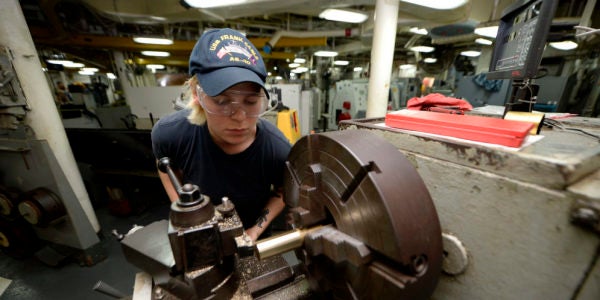What To Expect In A Manufacturing Career As A Veteran
There are plenty of routes to go once you leave the military. For many, it means going back to school....

There are plenty of routes to go once you leave the military. For many, it means going back to school. For some, it means stepping straight into industry. Manufacturing is often an attractive sector for veterans for a number of reasons. For one, jobs in this category can offer you the satisfaction of creating something, or being in charge of people who are creating things. Secondly, you generally don’t need to go back to school for those type of jobs. And, it’s a sector that includes a number of union positions, which come with benefits.
As for using skills you learned in the military, many plants operate like large units — company size, battalion size, or larger, so if you enjoyed working in a team environment with deadlines, safety measures, and goals to meet, manufacturing may be a natural fit for you.
According to the Bureau of Labor, manufacturing positions can be found at the following types of businesses, among others:
- Food and dairy plants
- Textile mills
- Plastics and rubber plants
- Paper mills
- Metal manufacturing plants
- Transportation equipment manufacturing
- Healthcare and pharmaceutical manufacturers
Positions range from entry level type roles, such as hourly machine operator or technician, to operations, engineering, and management roles, and all the way up to plant manager or director. Most places won’t place you at a manager level unless you have some sort of experience, which is where the military comes in. If you were an NCO or officer, you’ll have a better chance at coming in at a non-entry level position.
(U.S. Air Force photo/David Dixon)

AFRL Materials and Manufacturing Directorate researchers Capt. Sarah Wallentine and Alex Brown demonstrate the use of augmented reality for nondestructive inspections.
Some places will require certifications, such as OSHA or specialized equipment. If you already have a place in mind you’d like to work, you can see if you can knock out those certifications during your transition or ETS leave if on-the-job training isn’t offered.
You may also find that some companies, such as pharmaceutical companies or other more science-based manufacturing will require a bachelor’s degree. Again, it all depends on the company and its policies, so it’s best to familiarize yourself with job requirements by looking at job postings on Hirepurpose, Indeed, or Glassdoor.
Day-to-day
First of all, what you do day-to-day will depend on the rhythms of your company. You might start with shift work, as many plants run 24-hours a day. As a new hire, you might find yourself with the overnight or swing shifts — any time that’s not the desirable shift — until you move up the ranks.
What you do depends on what you’re manufacturing. Those working in paper mills will have different duties than those in food manufacturing. What you’ll likely find in common is that most places will have standard operating procedures (SOPs) much like what you’re used to from the military. With manufacturing comes standards and keeping things running smoothly, at scale, which takes coordination, communication, and enforcement of keeping consistent quality.
(U.S. Marine Corps photo by Staff Sgt. Britni M. Garcia Green/Released)

U.S. Marines with Special Purpose Marine Air-Ground Task Force-Crisis Response-Africa observe a 3D printer during an Additive Manufacturing course at Morón Air Base, Spain, June 27, 2018
Salary
According to the Bureau of Labor Statistics, hourly compensation is on average, $26, and average weekly hours worked for all employees in the manufacturing sector is about 41 total. That works out to $1,066 per week, before taxes. Of course, your pay will depend on your position and company, as well as how specialized you are or if you’re in a supervisory role.
Plant managers, according to PayScale, earn a median salary of about $81,000, while production supervisors earn $56,000, and operations managers earn a median of $79,600. Salaries also depend on where you’re located. For the most part, you’ll probably find higher pay in larger cities and lower pay in rural areas. You can arm yourself with knowledge of what type of salary to expect by using sites like PayScale and Glassdoor to get an initial idea.
(U.S. Navy photo by Mass Communication Specialist 3rd Class Christopher A. Veloicaza)

Lance Cpl. Trevor Wurster, Marine Wing Communications Squadron 18, observes a Lulzbot Taz 6 3D printer assembling a temporary ratchet aboard USNS Sacagawea (T-AKE 2) in support of an additive manufacturing test phase.
Benefits and more
For the most part, manufacturing offers some very decent benefits, especially in comparison with many other industries. While the hourly rate may be low to start, almost all full-time positions offer 401(k)s, paid vacation (generally much less than the 30 days you accrued per year in the military), health and dental insurance and life and disability insurance. Some will offer employee stock ownership, as well as paid training and uniforms. Of course, the most attractive jobs are union positions. These competitive — and harder to find — positions offer union benefits such as a pension (instead of a 401(k) or other self-directed retirement fund), higher wages, collective bargaining, and strict hours.
Last word on manufacturing
While U.S.-based manufacturing isn’t as common as it once was, you’ll still find plenty of open positions across the country. If you can, talk to people who work the job you think you want to have before applying. It always helps to get an inside scoop before committing to a career. And remember, as a veteran, you’re providing an asset to the company if you come in with your knowledge and experience. Seek out places with veteran friendly hiring practices, such as Staffmark, Johnson Controls, GSK, or Boeing, and you’ll be on your way to a successful, new career.
WATCH NEXT: